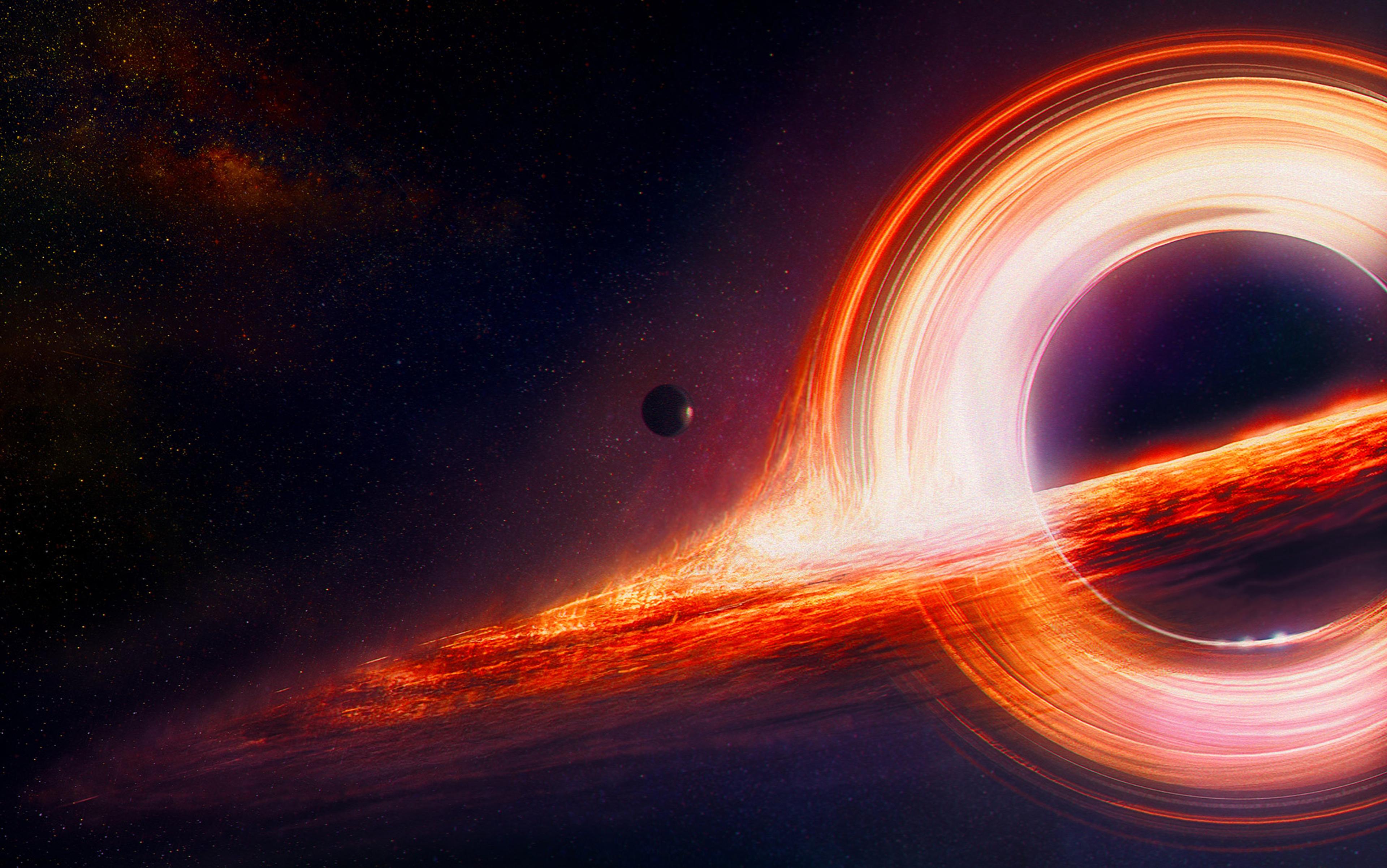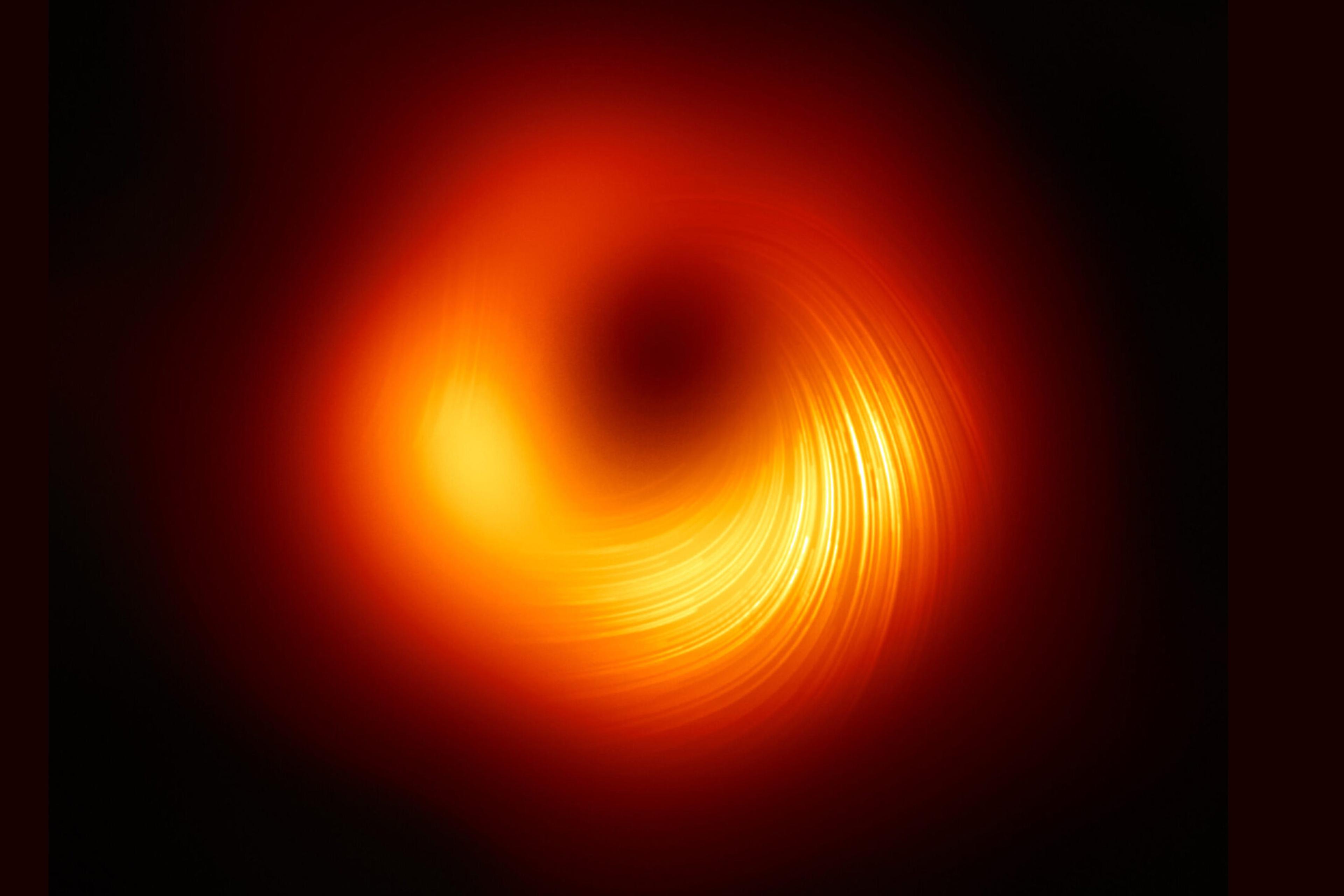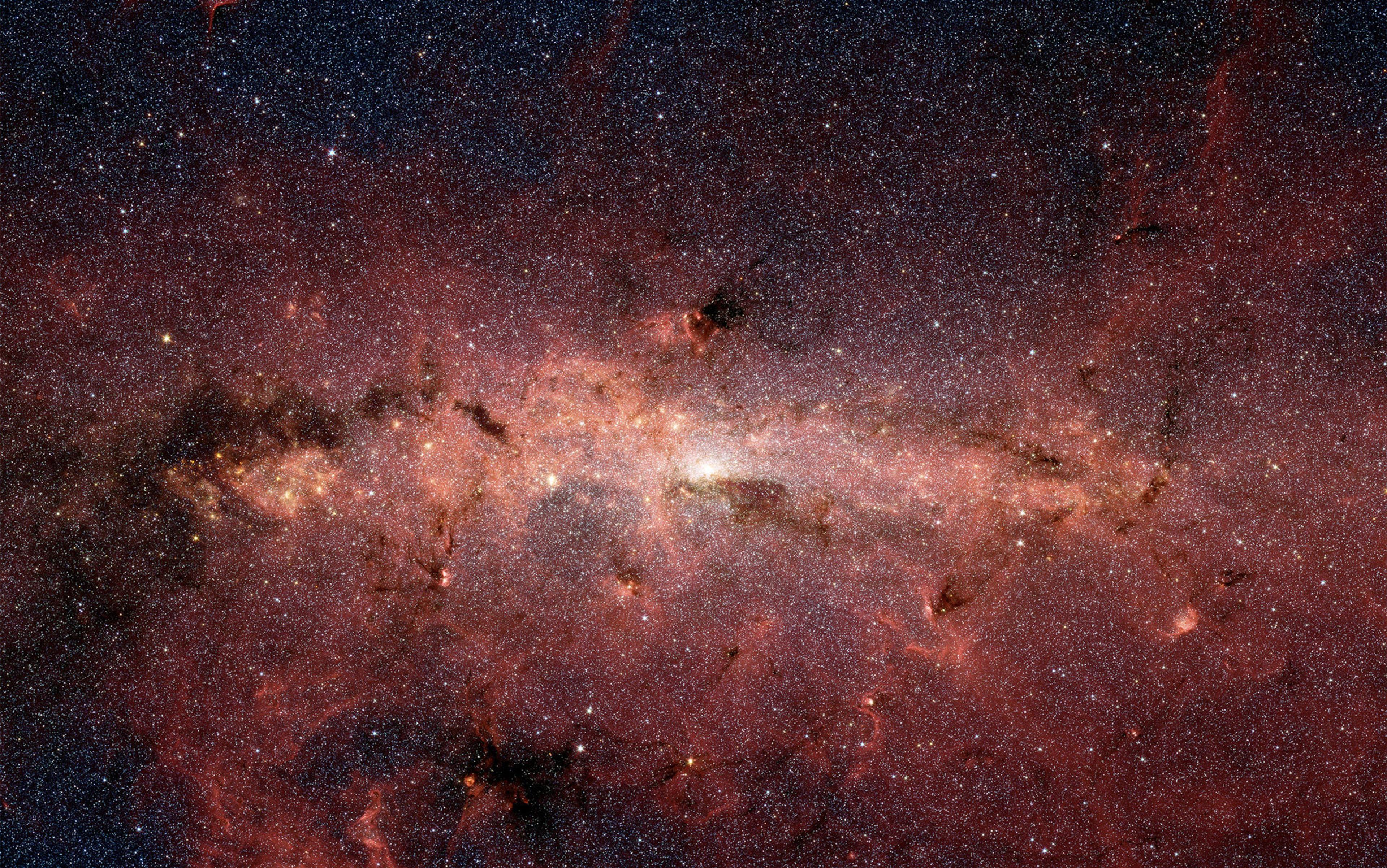After you die, your body’s atoms will disperse and find new venues, making their way into oceans, trees and other bodies. But according to the laws of quantum mechanics, all of the information about your body’s build and function will prevail. The relations between the atoms, the uncountable particulars that made you you, will remain forever preserved, albeit in unrecognisably scrambled form – lost in practice, but immortal in principle.
There is only one apparent exception to this reassuring concept: according to our current physical understanding, information cannot survive an encounter with a black hole. Forty years ago, Stephen Hawking demonstrated that black holes destroy information for good. Whatever falls into a black hole disappears from the rest of the Universe. It eventually reemerges in a wind of particles – ‘Hawking radiation’ – that leaks away from the event horizon, the black hole’s outer physical boundary. In this way, black holes slowly evaporate, but the process erases all knowledge about the black hole’s formation. The radiation merely carries data for the total mass, charge and angular momentum of the matter that collapsed; every other detail about anything that fell into the black hole is irretrievably lost.
Hawking’s discovery of black-hole evaporation has presented theoretical physicists with a huge conundrum: general relativity says that black holes must destroy information; quantum mechanics says it cannot happen because information must live on eternally. Both general relativity and quantum mechanics are extremely well-tested theories, and yet they refuse to combine. The clash reveals something much more fundamental than a seemingly exotic quirk about black holes: the information paradox makes it aptly clear that physicists still do not understand the fundamental laws of nature.
But Gia Dvali, professor of physics at the Ludwig-Maximilians University of Munich, believes he’s found the solution. ‘Black holes are quantum computers,’ he says. ‘We have an explicit information-processing sequence.’ If he is correct, the paradox is no more, and information truly is immortal. Even more startling, perhaps, is that his concept has practical implications. In the future, we might be able to tap black-hole physics to construct quantum computers of our own.
The main reason why recovering information from black holes seems impossible is that they are almost featureless spheroids with essentially no physical attributes on their horizons; they have ‘no hair’, as the late US physicist John Wheeler put it. You cannot store information in something that has no features that could be used to encode it, the standard argument goes. And therein lies the error, Dvali says: ‘All these no-hair theorems are wrong.’ He and his collaborators argue that gravitons – the so-far undiscovered quanta that carry gravity and make up space-time – stretch throughout the black hole and give rise to ‘quantum hair’ which allows storing as well as releasing information.
The new research builds on a counter-intuitive feature of quantum theory: quantum effects are not necessarily microscopically small. True, those effects are fragile, and are destroyed quickly in warm and busy environments, such as those typically found on Earth. This is why we don’t normally witness them. This is also the main challenge in building quantum computers, which process information using the quantum states of particles instead of the on-off logic of traditional transistors. But in a cold and isolated place, quantum behaviour can persist over large distances – large enough to span the tens to billions of kilometres of a black-hole horizon.
You don’t even need to go to outer space to witness long-range quantum effects. The enormous distances and masses necessary to create black-hole quantum hair might be far beyond our experimental capabilities, but by cooling atoms down to less than one ten-thousandth of a Kelvin (that is, one ten-thousandth of a degree above absolute zero), researchers have condensed up to a billion atoms, spread out over several millimetres, into a single quantum state. That’s huge for collective quantum behaviour.
Hawking’s information puzzle would find a natural solution if black holes are, in essence, puddles of condensed gravity
Such an atomic collective – known as a Bose-Einstein condensate, named after the Indian physicist Satyendra Bose and Albert Einstein – is currently one of the most promising tools for creating a workable quantum computer. Quantum effects within a Bose-Einstein condensate, like the ability to be in two places at the same time, can stretch through the whole condensate, giving rise to many interlocked states. Enormous information-processing power could become available if researchers succeed in stabilising the condensate and controlling these states. And, not coincidentally, Bose-Einstein condensates might also solve the decades-old puzzle of black-hole information loss.
Hawking’s information puzzle would find a natural solution, Dvali notes, if black holes consist of gravitons that have undergone Bose-Einstein condensation – puddles of condensed gravity, in essence. The idea might sound crazy, but for Dvali it’s a perfectly reasonable conclusion, drawn from what physicists have learned about black-hole information in the years since Hawking first posed his riddle. Theorists know how to calculate how much information the black hole must be able to store: the amount is quantified in the black hole’s entropy and proportional to the horizon surface area. They have also found that black holes can redistribute or ‘scramble’ information very quickly. And finally, they know the pace at which information must escape from the black hole in order to avoid conflicts with quantum mechanics.
Starting in 2012, Dvali explored these various attributes and discovered, to his surprise, that certain types of Bose-Einstein condensates share their essential properties with black holes. To act like a black hole, the condensate must linger at a transition point – its so-called quantum critical point – where extended fluctuations span through the fluid just before the quantum behaviour collapses. Such a quantum-critical condensate, Dvali calculated, has the same entropy, scrambling capacity and release time as a black hole: it has just the right quantum hair. ‘Somebody can say this is a coincidence, but I consider it extremely strong evidence – mathematical evidence that is – that black holes genuinely are Bose-Einstein condensates,’ he says.
Linking black holes with a form of matter that can be created in the lab means that some aspects of Dvali’s idea can be explored experimentally. Immanuel Bloch, professor of physics at the Max-Planck-Institute in Munich, has first-hand experience with Bose-Einstein condensates. He condenses atoms in ‘crystals of light’ – optical lattices created by intersecting multiple laser beams – and then takes snapshots of the condensate using a technique called fluorescence imaging. The resulting pictures beautifully reveal the atoms’ correlated quantum behaviour.
Bloch finds Dvali’s idea, which originated in a field entirely different from his, intriguing. ‘I am pretty excited about Gia’s proposal. I think that’s something really new,’ Bloch says. ‘People have seen collapse dynamics with interacting condensates, but nobody has so far investigated the quantum critical point and what happens there.
‘In the BEC [Bose-Einstein condensate] you have macroscopic quantum waves, and this means in the quantum numbers you have a lot of fluctuations. This is why the BEC normally looks like a Swiss cheese,’ he continues. But by applying a magnetic field, Bloch can change the strength by which the atoms interact, thereby coaxing them into an orderly lattice. ‘Now you make the atoms strongly interacting, then you go to the [very orderly] “Mott state”. This is a great state for quantum computing because you have this regular array. And you can address the atoms with lasers and rotate them around and change the spin [to encode and process information].’
‘Dvali’s idea is competing with a lot of other stuff out on the market. I have more skepticism than faith’
According to Dvali, black-hole physics reveals a better way to store information in a Bose-Einstein condensate by using different quantum states. Black holes are the simplest, most compact, most efficient information storage devices that physicists know of. Using the black holes’ coding protocol therefore should be the best possible method to store information in condensate-based quantum computers.
Creating a black-hole-mimic condensate in the lab seems doable to Bloch: ‘[In a black hole,] the interaction strength adjusts itself. We can simulate something like that by tuning the interaction strength to where the condensate is just about to collapse. The fluctuations become bigger and bigger and bigger as you get closer to the quantum critical point. And that could simulate such a system. One could study all the quantum fluctuations and non-equilibrium situations – all that is now possible by observing these condensates in situ, with high spatial resolution.’
Just because realising Dvali’s idea is possible does not necessarily mean it is practical, however. ‘It’s competing with a lot of other stuff out on the market. Right now, I have more skepticism than faith,’ Bloch says. He also points out that efficient information storage is nice, but for quantum computers ‘information capacity is presently not the problem’. The biggest challenge he sees is finding a way to individually manipulate the quantum states that Dvali has identified – data processing, rather than data storage. There are other practical hurdles as well. ‘There are so many things we don’t know, like noise, is it resistant to noise? We don’t know,’ Bloch notes. ‘For me, the much more interesting aspect is the connection to gravitational physics.’ And here the implications go well beyond information storage.
Dvali’s is not the only recent research suggesting a connection between gravity and condensed-matter physics, a trend that has opened whole new realms to experimental investigation. In the tradition of Einstein, physicists generally think of curved space-time as the arena for matter and its interactions. But now several independent lines of research suggest that space-time might not be as insubstantial as we thought. Gravity, it seems, can emerge from non-gravitational physics.
In the past decades, numerous links between gravity and certain types of fluids have demonstrated that systems with collective quantum behaviour can mimic curved space-time, giving rise to much the same equations as one obtains in Einstein’s theory of general relativity. There is not yet any approach from which general relativity can be derived in full generality by positing that space-time is a condensate. For now, nobody knows whether it is possible at all. Still, the newfound relations allow physicists to study those gravitational systems that can be mimicked with atomic condensates.
Simulating gravity with condensates allows physicists to explore regions – such as black-hole horizons – that are not otherwise accessible to experiment. And so, although Hawking radiation has never been observed in real black holes, its analogue has been measured for black holes simulated through Bose-Einstein condensates. Of course, these condensates are not really black holes – they trap sound waves, not light – but they obey some of the same mathematical laws. The condensates do thus, in a sense, perform otherwise complicated, even intractable, physics calculations.
‘We like to speak of “quantum simulations” and try to use these systems to look for interesting phenomena that are hard to calculate on classical computers,’ says Bloch. ‘We are also trying to use this kind of system to test other systems like the black holes, or we looked at the [analogue of the] Higgs particle in two dimensions.’ In a 2012 Nature paper, Bloch and his collaborators reported that their quantum simulation revealed that Higgs-like particles can also exist in two dimensions. The same technique could in principle be used to study Bose-Einstein condensates behaving like black holes.
‘The black hole [no hair] theorems are, sorry, crap’
But using black-hole physics to develop new protocols for quantum computers is one thing. Finding out whether astrophysical black holes really are condensates of gravitons is another thing entirely. ‘I am not interested in the idea if one can’t test it,’ says Stefan Hofmann, a theoretical cosmologist and colleague of Dvali’s in Munich.
Hofmann therefore has dedicated significant time to exploring the observational consequences of the idea that black holes are graviton condensates. ‘The black hole [no hair] theorems are, sorry, crap,’ he agrees with Dvali. Hofmann thinks that the quantum hair nearby the black-hole horizon would subtly alter the predictions of general relativity (especially the emission of gravitational waves during formation or collision of black holes), in ways that should be detectable. ‘The dream would be a binary [black hole] merger,’ Hofmann said in a 2015 seminar. His dream has just become true: the LIGO collaboration recently announced the first measurement of gravitational waves emitted from a merging pair of black holes.
Hofmann and his collaborators have yet to make quantitative predictions, but due to the macroscopic quantum effects, Dvali’s proposed solution to the information-loss problem might soon become experimentally testable. However, the idea that black holes are quantum-critical condensates of gravitons, truly equivalent to a Bose-Einstein condensate, leaves many questions open. To begin with, Dvali’s calculations cannot explain what actually happens to matter falling into a black hole. And Hofmann admits that it isn’t clear how the object is a ‘black hole’ in the conventional sense, since it can no longer be described within the familiar framework of general relativity.
Carlo Rovelli from the University of Marseille thinks that, even in incomplete form, Davli’s idea of black holes as condensates might be scientifically useful. ‘They are using a brutal approximation which might fail to capture aspects, but it might work to some extent, especially in the long wavelength regime. For the low-frequency quantum fluctuations of [space-time] it may not be absurd,’ Rovelli says. He cautions, however, that the condensate model ‘cannot be a complete description of what happens in the black hole’.
What is clear, though, is that this research has revealed a previously unrecognised, and quite fruitful, relation. ‘We have a very interesting bridge between quantum information and black-hole physics that was not discussed before,’ Dvali says. If he is right, the implications are conceptually staggering. Information really does live on eternally. In that sense, we are all immortal. And the supermassive black hole at the centre of our galaxy? It’s actually a cosmic quantum computer.






